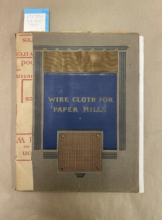This month’s Artifact of the Month exhibit showcases a Japanese Kyo uchiwa fan, which is a flat fan that does not open.
This month's Artifact of the Month, a photograph of handmade paper expert Harrison Elliott (1879-1954) examining a sheet of handmade paper, is (un)coincidentally connected to the museum's current exhibit - which is all about the man himself!
Categories:
Paper Fibers/Pre Paper
Keywords:
Books, Handmade
Japanese washi figurines from the 1998
Categories:
3-D Objects
Keywords:
Washi
This month’s Artifact of the Month, the last of 2020, is all about a year-in-review; it is an original Saturday Evening Post from 1954.
Categories:
Paper Fibers/Pre Paper
Keywords:
Books, Letterpress
This month’s artifact is from our permanent exhibit; it is a book printed in 1800 entirely from straw. Historical Account of the Substances Which Have Been Used to Describe Events and to Convey Ideas from the Earliest Date to the Invention of Paper by Matthis Koops.
Categories:
Archival Materials, Paper Fibers/Pre Paper
Keywords:
Artist's Books, Books, Handmade
This month’s Artifact of the Month is from our Rare Book Library: Wirecloth for Paper Mills, published in 1925 by Rai Wire Works of the French Compagnie de Général D'électricité (aka the General Electricity Company).
Categories:
Tools
Keywords:
Tools
This month’s artifact is a calendar for August 1918, printed by the Marchbanks Press
Categories:
Archival Materials
Keywords:
Ephemera
Paper Trade Journal: Convention issue, 1907
Categories:
Archival Materials
Keywords:
Ephemera
This month’s “Artifact of the Month” is a collection of lithograph prints by Swedish artist Lars Norrman (1915 – 1979).
Categories:
Decorative Papers
Keywords:
Artist










